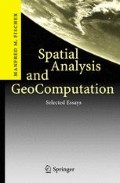Abstract
This chapter views learning as an unconstrained nonlinear minimisation problem in which the objective function is defined by the negative log-likelihood function and the search space by the parameter space of an origin-constrained product unit neural spatial interaction model. We consider Alopex based global search, as opposed to local search based upon backpropagation of gradient descents, each in combination with the bootstrapping pairs approach to solve the maximum likelihood learning problem. Interregional telecommunication traffic flow data from Austria are used as test bed for comparing the performance of the two learning procedures. The study illustrates the superiority of Alopex based global search, measured in terms of Kullback and Leibler’s information criterion.
Access this chapter
Tax calculation will be finalised at checkout
Purchases are for personal use only
Preview
Unable to display preview. Download preview PDF.
References
Bia A. (2000): A study of possible improvements to the Alopex training algorithm. In: Proceedings of the VIth Brazilian Symposium on Neural Networks, IEEE Computer Society Press, pp. 125–130
Bishop C.M. (1995): Neural Networks for Pattern Recognition, Clarendon Press, Oxford
Cichocki, A. and Unbehauen R. (1993): Neural Networks for Optimisation and Signal Processing, John Wiley, Chichester [UK], New York
Efron B. (1982): The Jackknife, the Bootstrap and Other Resampling Plans, Society for Industrial and Applied Mathematics SIAM, Philadelphia
Fischer M.M. and Reismann M. (2002a): Evaluating neural spatial interaction modelling by bootstrapping, Networks and Spatial Economics 2(3), 255–268
Fischer M.M. and Reismann M. (2002b): A methodology for neural spatial interaction modelling, Geographical Analysis 34(3), 207–228
Fischer M.M., Reismann M. and Hlavackova-Schindler K. (2003): Neural network modelling of constrained spatial interaction flows: Design, estimation and performance issues, Journal of Regional Science 43(1), 35–61
Harth E. and Pandya A.S. (1988): Dynamics of ALOPEX process: Application to optimization problems. In: Ricciardi L.M. (ed.) Biomathematics and Related Computational Problems, Kluwer Academic Publishers, Dordrecht, Boston, London, pp. 459–471
Hassoun M.M. (1995): Fundamentals of Neural Networks, MIT Press, Cambridge [MA], London [England]
Kirkpatrick S., Gelatt C.D. Jr. and Vecchi M.P. (1983): Optimization by simulated annealing, Science 220, 671–680
Kullback S. and Leibler R.A. (1951): On information and sufficiency, Annals of Mathematical Statistics 22(1), 78–86
Press W.H., Teukolsky S.A., Vetterling W.T. and Flannery B.P. (1992): Numerical Recipes in C: The Art of Scientific Computing, Cambridge University Press, Cambridge [MA]
Rumelhart D.E., Hinton G.E. and Williams R.J. (1986): Learning internal representations by error propagation. In: Rumelhart D.E., McClelland J.L. and the PDP Research Group (eds.): Parallel Distributed Processing: Explorations in the Microstructures of Cognition, MIT Press, Cambridge [MA], pp. 318–362
Rumelhart D.E., Durbin R., Golden R. and Chauvin Y. (1995): Backpropagation: The basic theory. In: Chauvin Y. and Rumelhart D.E. (eds.): Backpropagation: Theory, Architectures and Applications, Lawrence Erlbaum Associates, Hillsdale [NJ], pp. 1–34
Unnikrishnan K.P. and Venugopal K.P. (1994): Alopex: A correlation-based learning algorithm for feedforward and recurrent neural networks, Neural Computation 6(3), 469–490
Rights and permissions
Copyright information
© 2006 Springer Berlin · Heidelberg
About this chapter
Cite this chapter
(2006). Learning in Neural Spatial Interaction Models: A Statistical Perspective. In: Spatial Analysis and GeoComputation. Springer, Berlin, Heidelberg . https://doi.org/10.1007/3-540-35730-0_13
Download citation
DOI: https://doi.org/10.1007/3-540-35730-0_13
Publisher Name: Springer, Berlin, Heidelberg
Print ISBN: 978-3-540-35729-2
Online ISBN: 978-3-540-35730-8
eBook Packages: Business and EconomicsEconomics and Finance (R0)

